#i also love paracelsus
Explore tagged Tumblr posts
Text
OG Red Hair A.B.A or Blue Hair A.B.A?!? I LOVE THEM BOTH!!!!!!!!!!
12 notes
·
View notes
Text
I like them a lot they are sooo silly
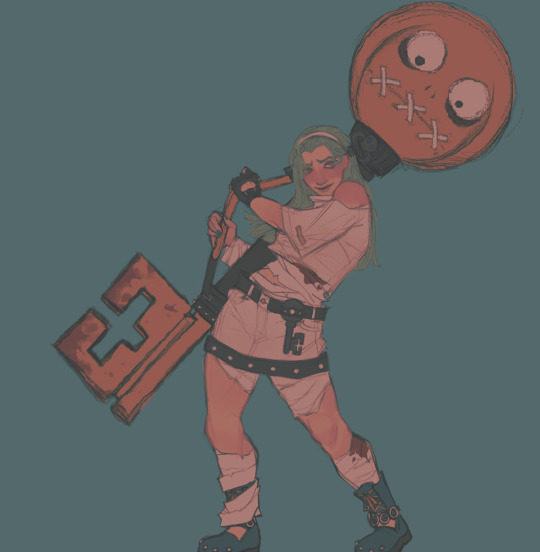
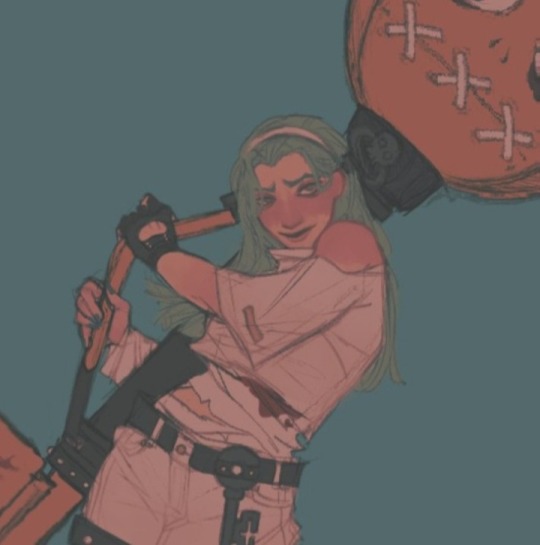

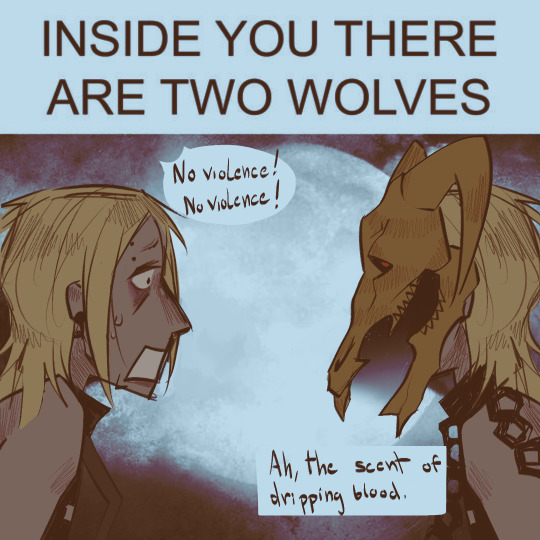
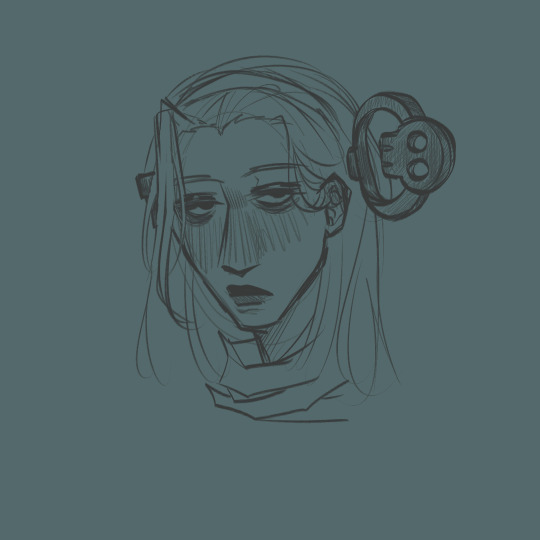


they are the healthiest unhealthy couple ever
#guilty gear#guilty gear strive#guilty gear aba#aba guilty gear#paracelsus#guilty gear paracelsus#guilty gear fanart#I've been obsessing over them for the past week and I had to get it out of my system yk#also aba's theme goes so hard i love it so so much
674 notes
·
View notes
Text


I finished that fanart I was working on! ^///^)/
Hi, so like, I know next to nothing about Guilty Gear I just really really liked whatever the hell these two got going on LMAO- Got suggested some videos and then proceeded to look up everything about her. I sure do love a girl who's weird, and she's so unwell. <3
But yeah!! :D Turned out surprisingly well imo, I'm happy with it. :3c
#I don't often do fanart#it was fun tho!#her original design is also neat I just quite like this shade of green#my favorite part of her design is that her shirt is also pants#just with sleeves sewn on this time#hysterical 10/10 gotta love that#mocks art#aba ggst#aba guilty gear#guilty gear#guilty gear strive#aba#paracelsus#abacelsus
269 notes
·
View notes
Text
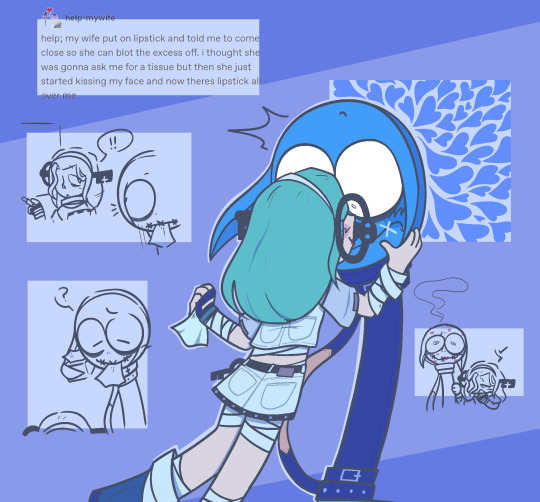
HAPPY PARACELSUS HAS CANONICALLY ACCEPTED BEING ABAS HUSBAND AKA ABAPARA WIN DAY
#digital art#guilty gear#a.b.a guilty gear#aba guilty gear#paracelsus guilty gear#abacelsus#aba x paracelsus#FRIENDSHIP ENDED WITH SLAYER RELEASE DAY NOW IM CELEBRATING ABAPARA WIN DAY#arcsys failed me with not giving slayer and aba unique interactions then apologized by making abapara fully canon#LOVE IS REAL . LOVE WINS .#two days till pride month and these two are already queering it up#also yes para is blue THE ARCADE MODE ENDING MAKES ME NORMAL OK .#i'm not even gonna lie i stole that meme from a slayer image SORRY MAN
338 notes
·
View notes
Text





Happy summer, everybody!
This has been a big project to take and while there's stuff to improve I'm pretty happy with it. Be sure to zoom in the big picture for details and read the comic from left to right. (Needless to say, please don't try A.B.A's behaviour.. For your safety)
Bonus doodle:

#a.b.a#paracelsus#slayer#guilty gear#I almost forgot slayer's shirt pattern! I was also supposed to draw his cape floating over sharon to shield her from the sun but...#this whole drawing collection took roughly a month to complete and I forgot. I'm too tired right now#speaking of. it's my first time drawing sharon I hope she's okay!#yes slayer carries and wears in the nose his 200 spf sunscreen from xrds treasure hunt animation :)#as for the big main picture. it left me quite exhausted and I know the lighting leaves a lot to be desired but I'm proud! learnt a lot#first time drawing blue para too. I hope his metallic sheen is alright#more than aba's skin sheen for sure. I'll improve it in the future! btw tweaked a bit her attire's palette from last time and made her keep#the headband cause trying to figure out how her hair would properly fall was a hassle lmao#fun fact: the bird is an european herring gull#the crab is an edible crab and the palm trees are coconut palm trees with no fruit lol#I wanted to draw fan palms which are a kind of palm tree that deserves more love but the leaf shape was so difficult to draw#I did struggle a lot with these two.. they look more like feathers but again. that can be studied and improved in the future#despite all the lows summertime can have for me whenever it's a nice day and we can go to the beach I feel everything is worth it and will#be okay. hope I could translate that here. hi new people I tend to ramble a lot in my post tags#art tag2b named#sharon
66 notes
·
View notes
Text
ABAcelsus keychain designs 🗝️🩸

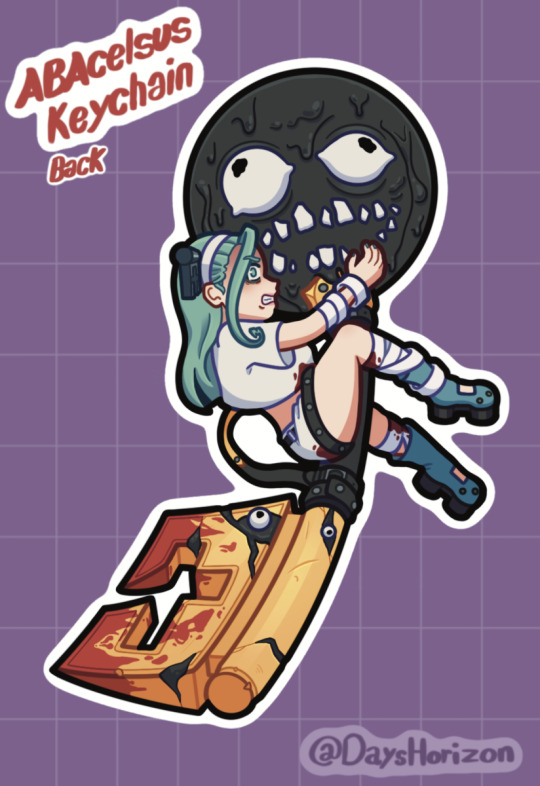
I love this dedicated wife and her axe husband 🩵💛
#guilty gear#guilty gear strive#ggst#ggstrive#abacelsus#a.b.a#paracelsus#art#illustration#digital art#fanart#they've constantly been on my mind since release#i'm making these into actual keychains!#probably won't sell them because i'm scared of that#dayis art#WARNING ranting ahead#ougghh their recent lore drop for slayer's update made me tear up#aba is so scared of him leaving her#he KNOWS he can have a body but he doesn't say anything#also i love that aba got into fashion#she's so me (kind of)#paracelsus might have a body the next game they show up in#he'll probably be able to switch between forms or something#idk how thatll work gameplay wise#idk x2 because he doesnt even want a body#unless hes more open to the idea now#aaah#i love them so much
130 notes
·
View notes
Note
People always give Paracelsus a human design, but nobody ever seems to consider giving ABA a goofy weaponsona.
Lotsa people are drawing human Paracelsus since he did get a design in a non-canonical ending. (if u already knew this then ignore it)

I've only seen 1 artwork of someone giving ABA a weapons form. It's really good!
#paracelsus is a rare situation where i both love his key axe form AND his human design#i think because it rly does match his look well#he still looks like a sleep deprived weirdo#love it#also#ABA what the fuck are you cooking for dinner there#guilty gear
49 notes
·
View notes
Text
W E L L
My first ever edit??? With Plague Doctor/Paracelsus from dd??? Crazy crap
btw song: Sabaton - Father
animated Plague Doctor backstory: RPGente (youtube)
character and animation: Darkest Dungeon (2)
#darkest dungeon#darkest dungeon 2#plague doctor#dd plague doctor#dd edit#edit#dd paracelsus#i love her so much she so interesting character with so complex mind#also she's so gremlin coded idk
10 notes
·
View notes
Text
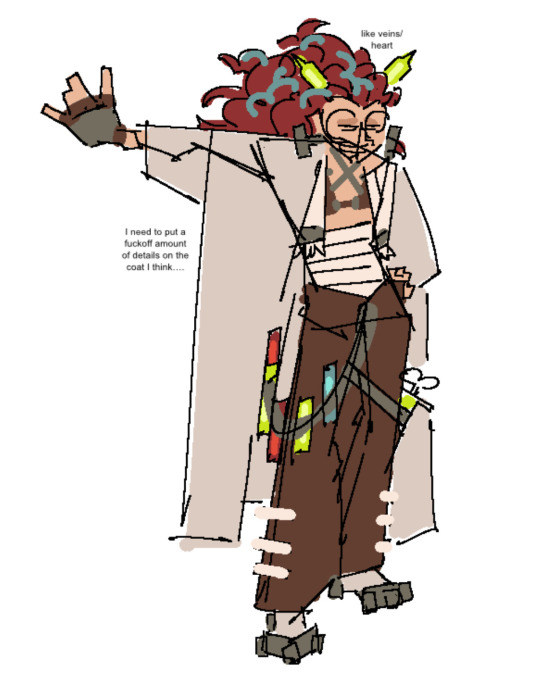
I saw a post the other day that made me think about this…. Just a rough design because I had to get the vision out of my head but here’s paracelsus as in the one who created aba design. AND she’s a girl becsuse im awesome
#funky!art#guilty gear#uuuugghhhhhh I love character designnnn….#idk if there’s an audience for this LOL I don’t even care I just like designing stuff#design details because I like talking about that stuff. hair is red but also blue like aba colors bandages of course stitches on pants but#a different type of stitch than the ones paracelsus (key) has. because she’s different#things on her head to mirror the key on abas head but it isn’t a key. frankenstein bolts because she’s a mad scientist#and because it felt right.#hard to see but the ‘vest’ under the coat is actually a skirt LOL aba style.#i might refine this design more or draw her more. Or maybe I’ll just never do anything with this again we’ll see 👍#i don’t like the way the face and arm look but idc that’s not the focus here
43 notes
·
View notes
Text
I’ve been playing Guilty gear strive recently and it’s been fun,so I drew A.B.A because I like her design and she seems to be getting popular.
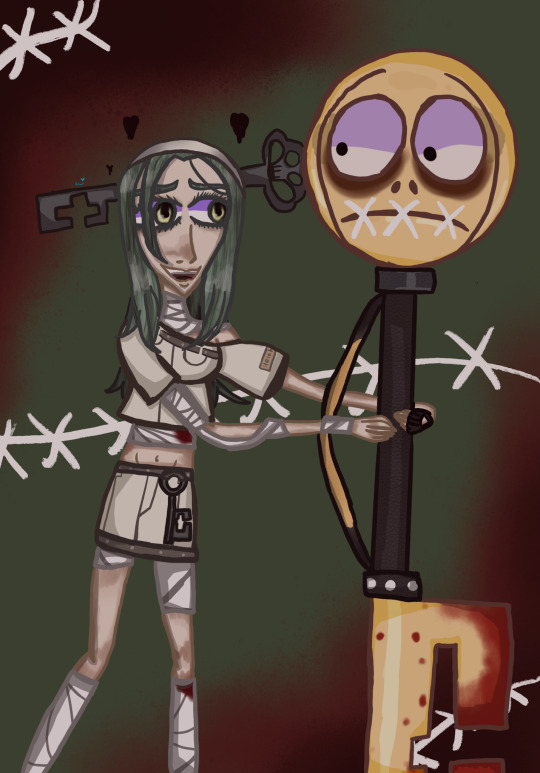
#honestly I’ve been maiming ZATO and I love playing him tbh.#also I’m sorry Para looks off#he’s just a little guy#but A.B.A is me fr-#also like this a lot lol-#guilty gear#aba guilty gear#paracelsus#art#artists on tumblr#fanart#guilty gear strive
24 notes
·
View notes
Text
whenever I see art of human paracelsus I start giggling and kicking my feet

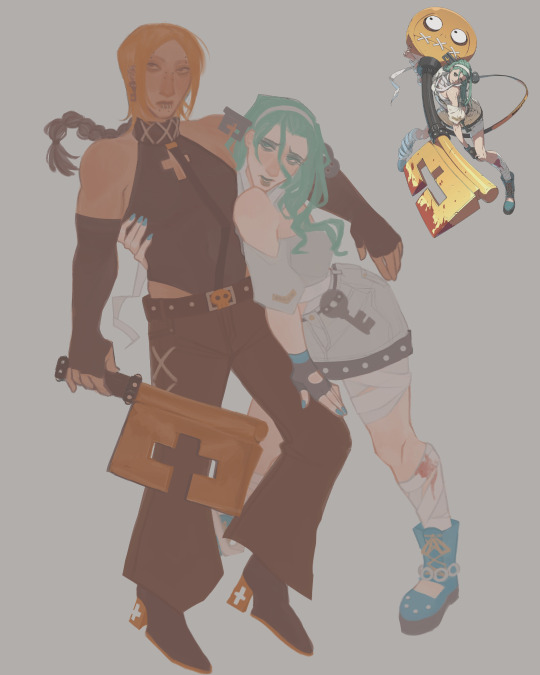




#guilty gear fanart#aba guilty gear#guilty gear#guilty gear aba#guilty gear paracelsus#guilty gear strive#paracelsus#I love seeing human designs for him#they always look so cool#also ty for all those notes on my last post <3
446 notes
·
View notes
Text
There's a fascinating aspect of Ellen's character that I've seen some people touch on before, but now that it got into my head I need to go through to it too-- her nature not being of human kind. It's actually one of the very first things Orlok himself says: that Ellen is not human, and he reasserts it later. But then what is she?
"Almost a sylph," Knock says of Ellen. "His little changeling girl," Ellen says her father had described her as, when she wandered off into the forest as a child. "You mustn't be caught up in her fairy ways," Harding admonishes Anna. Hell, in the 2016 script, when the Hardings accompany Ellen on her walk along the sea shore, she and the children dance in a circle while Ellen cries out "round and round the fairy ring". Furthermore, there's more than one explicit reference to Ellen loving the sea in the scripts. Prior to the sea shore walk, Ellen fervently asks Anna to go there, because "it calms her". Later on, Anna herself says that "she loves the sea so". While this didn't make it to the movie in such direct terms, we still see Ellen looking out windows and yearning, again and again... visiting the sea twice, having a seizure in the water itself. "Look at the sky! Look at the sea! Does it never call to you? Urge you?" she cries to Anna.
It's clearly an intentional implication on Eggers' part: that Ellen is some kind of fairy-like nature elemental. The term sylph originates from the works of Paracelsus, and described as a female air spirit, though over time water has been conflated with it too. Changeling also refers to a child kidnapped by supernatural beings (interestingly birthed by the Devil or a water spirit among others, in German mythology) and replaced with... something else. And we could leave it at that-- Ellen is not entirely human. She was born with witchy and fae-like characteristics, an attraction to the wind and the sea.
When she called out in the dark, it's possible Orlok answered also because he recognized this within her. But. There is a type of female nature spirit in Romanian folklore (which ultimately pervades the mythology of Nosferatu) that has specific parallels and a particular relationship to the Solomonar, the kind of sorcerer/supernatural creature Orlok was in life. It feeds into the overarching theme of destiny and fate so beautifully. I find it all very interesting, but I got pretty long already, so I'll put the rest under the cut.
Female nature spirits can be found all over the place in European folklore, and Romania is no different. They can have many names, though the most popular one is probably iele, a name that is literally derived from the female plural "ele". Iele are fae-like feminine spirits associated with the winds and the sky, often seducing and luring men away. What attracted my attention though, is the variation/subtype of vântoase (root word vânt = wind) or the associated vâlvă. In some accounts [1], this supernatural creature is a marked human who was born with the capacity for their spirit to leave their body at night and then go towards the sky, where they wrestle with other vâlve or balauri (which are a Romanian mythical equivalent of dragons, alongside zmei). Their fights are said to be what cause storms, and rains, and other catastrophe-related weather events. When put in contrast with Ellen, the similarities are obvious... especially when it comes to her affinity for nature and her spirit "wandering off". It also must be emphasized that these spirits are not inherently evil: they can do both good and bad, bring luck or misfortune, aligning with Ellen saying that "her spirit cannot be as evil as his [Orlok's]" and that all her life she has "simply heeded her own nature".
But the thing is... a marked human born with powers is also what a Solomonar is: children able to control the weather, ride balauri or zmei, control and turn into different animals-- who are then recruited by the Devil into the school of Șolomanță/Scholomance. Although despite this demonic current association, initially Solomonari were also more of a neutral figure in Romanian folklore. They are theorized, among other hypotheses, to be a later version of Geto-Dacian ktistai, who were selected from priests or kings (Orlok is a count, a prince or voivode) and might've worshipped Zamolxe, a Geto-Dacian God associated with the sky as well as immortality (Ancient Dacian is what Orlok speaks; Zamolxe is written within Orlok's heptagram sigil; on his coat of arms, sigil and coffin there's Dacian wolves as well as balauri-- a serpent-like creature with the head of a wolf which is on the Dacian flag). Some Solomonari were believed to be protecting villages from calamity, and influenced the weather in order to grow crops more easily. But of course, when Christianity spread in the region, things from Pagan times began to be associated with the Devil, hence why the Christian Orthodox Abbess we see in the Nosferatu movie calls Orlok a "black enchanter". More importantly for us though, the Solomonar was also said to leave their body at night in a trance, riding up into the sky to fight the weather spirits. Orlok's Shadow, that we hear so much about, is an integral part of a Solomonar's powers: the ability to project one's spirit away from their body. Them riding balauri is a metaphor for them taming winds, summoning vântoase.
So. Vâlvă, vântoasă, ială and Solomonar share quite a lot of characteristics, don't they? A source I found made the comparison directly, which is what set me on this path [1]. Humans born with powers-- one typically male, one female. But the male one is schooled and part of a cult or hierarchy, taking control of the nature element, while the vâlvă/vântoasă/ială is the nature element.
Yet the expected dynamic between summoner and summoned is so deliciously subverted with Ellen and Orlok! Orlok definitely recognized someone of his own nature in Ellen. Someone born with magic, essentially. Someone not of human kind. But Ellen's power is something Orlok's kind traditionally controls. A Solomonar tames and summons the winds (vântoasele)... and don't we see Orlok's spirit call to Ellen more than once? Orlok asserts his influence through the lilac-scented lock of hair, latching onto Ellen through it. He trespasses in Ellen's dreams, brings her spirit to him in the Castle when he feeds on Thomas, and we see her naked and on top of Thomas too, eerie and with blood spilling out of her mouth (very female-spirit-who-preys-upon-men coded, which is even more directly spelled out later in the scene where Ellen provokes Thomas into having sex with her). All along, we see Ellen overcome by seizures and trances, writhing under Orlok's Shadow. This is the power he has over her.
Hah. But Orlok is not just a Solomonar, Ellen is not just a spirit of the wind, and here's where I think another fascinating layer comes in. In the movie, ultimately, Orlok is a strigoi. The strigoi is a Romanian folk creature that can be vampiric, though that's not always what it does. It's a troubled spirit that rises from the grave to prey upon the living (especially their loved ones, to whom they return to first), by eating/killing their animals, poisoning their crops, drinking their blood and creating all manner of disaster. One can become a strigoi in many ways, including a life of sin, suicide, being cursed by a witch, etc. But importantly, there's also two types of strigoi-- the alive strigoi, and the dead strigoi [2]. The alive type is a sorcerer who in life already slips into these evil behaviors with intent, while the dead type rises from the grave and mindlessly feeds upon their loved ones and their village (the revenant we see killed by the Romani vampire hunter in the film). Orlok is a mix of things that make him unique, much like how Dracula was described as atypical multiple times in Bram Stoker's novel. He was a sorcerer and a Solomonar in life (an alive strigoi, something a source from the 19th century asserted-- that Solomonari were strigoi), who was then risen from the grave by a witch (becoming a dead strigoi). As a result, he has retained all his mental faculties and his magical powers.
But the enchantress who calls upon Orlok as a strigoi is partly an air elemental. She caused him to rise from the grave, and that is how she asserts her power over him. Yet she's of the air, of the wind, of the sea... all the things a Solomonar is a master of! So I think this is a contributing factor to the Covenant Orlok makes with Ellen. When they first meet there is not only recognition of someone similar to himself ("You... You..."), but also of a specific connection between what the two of them are. He immediately seeks a Covenant with Ellen, and then when she breaks it, comes after her in person. When they first talk and Ellen rejects him, he says "You will submit."
As Eggers pointed out too, there is a huge need for possession on Orlok's side. It's left ambiguous if he wants to own her or destroy her or if he loves her... To me, this added aspect illuminates a big part of why Orlok also resents Ellen ("You are my affliction"). It isn't just that a woman has him in her thrall, a man and a Lord who wielded great power in life-- but also that she is air, a vântoasă, the element of his dominion. It's so delicious how there's a bidirectional supernatural element between them... Orlok may feel he is owed possession of Ellen, with the deeper layer of the male sorcerer taming the unknowable chaotic female elemental. But Orlok is a strigoi risen from the grave by Ellen as an enchantress, hence she is owed possession of him as her summoned Creature. So there's two tethers between them, each connected to a different aspect of their natures; Orlok is holding one end, Ellen is holding the other. (To be honest, my headcanon is that when we see Ellen levitate, that's not Orlok, it's her air-related power. She levitates upwards in the very first scene of the film right as Orlok says she isn't human, as if it's a manifestation of that. When Orlok feeds on Thomas and she is there in spirit, we see them levitate; except it's Ellen we see fall down to the ground, while Orlok and Thomas are shown to have always been on the ground. And in every scene with Orlok in person, it could be that she gets on her tiptoes progressively to get closer and closer to his face; but it also looks as if she's floating upwards.)
This ended up a way too long honest-to-God essay, but I just adore all the complexities of this movie. You can tell how much Eggers researched, how many details and references he wove into the story, all meant to connect but kept ambigous enough that multiple theories are possible. While the association between Solomonar and strigoi and vampire was something Stoker did too, that Murnau did too, none of them thought to take it as far as creating a connection to Ellen steeped also in folklore. The vampire has a supernatural hold over his bride, but now so does she. The Enchantress summons the undead Strigoi, the Solomonar summons the Vântoasă. How much more fated can you get?
I'm supplying two more in-depth sources I used below as downloadable pdfs, but fair warning, they're in Romanian:
[1] Mituri pluviale românești în context universal, Silvia Ciubotaru
[2] Șapte Eseuri Despre Strigoi, Marineasa, 1998
#[SIGH] this is one deep dive out of two. because another one will be my insane quest#to figure out what Hungarian nobleman Eggers combined with Dracula/Vlad Țepeș to make Orlok. everyone pray for me#nosferatu 2024#nosferatu 2024 meta#ellen x orlok#count orlok#ellen hutter#nosferatu 2024 spoilers#nosferatu meta#nosferatu
254 notes
·
View notes
Text
Analysis of Paracelsus' initial bloodlust and its longlasting effects on A.B.A (Part 2)
Analysis behind the backstory and personal story arcs of A.B.A. and Paracelsus (part 1)
So this actually started out more of a 'funny' post, but I realized that it really is a very important insight into how A.B.A. and Paracelsus function and interact, especially for his earlier days in XX/Accent Core +R
And I wasn't joking about the vore. It's not in the erotic sense...but it certainly is in the 'literally eating parts of your partner ' sense...
Also apologies for the long word dumps, it got wordier and longer than I expected.
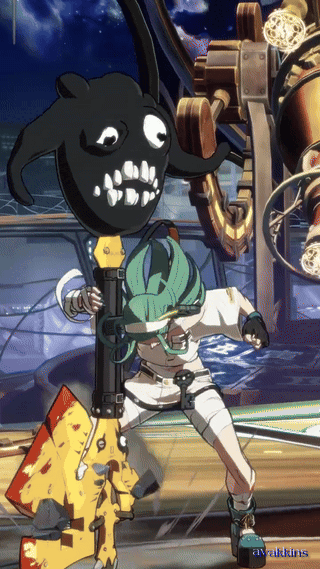
Paracelsus (used to) REALLY love blood
It goes without saying, Paracelsus really loves blood. Well he used to anyway.

By STRIVE, he says he felt he lost his sanity whenever he gets hyped on blood in the past. To the point, he has sworn off blood (and violence) as if it was an addiction. Basically, he has managed to go clean sometime between their last appearance and STRIVE.
To not go too far into his backstory again (which you can read here), Paracelsus is a magical axe that fed on blood and increased his own power with blood; and would use warriors as hosts to cause more bloodshed and thus gain more blood and power for himself. Paracelsus doesn't need to 'eat' blood to survive (he was left host-less for about 20 years, and now abstains in STRIVE and is just fine), making the addiction metaphor seem to be accurate.
Back in XX/ACCENT CORE, he needed to drink fresh blood to transform into his superpowered Moroha mode (this is mechanically replaced by Jealous Rage mode now). Similar to his current gameplay, he could get blood and transform by A.B.A. piercing someone with his bladed end; or if A.B.A. fed him one of three blood packs she'd have on her.

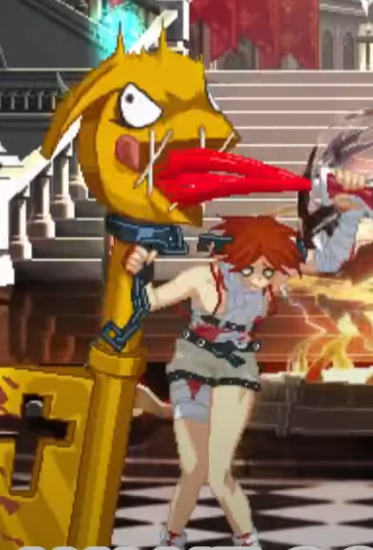
He reacts pretty much like a dog getting a treat, anticipating it when she reaches into her pockets for a pack too. And he truly didn't care where the blood comes from, even if it's from A.B.A. herself.
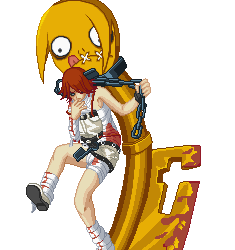
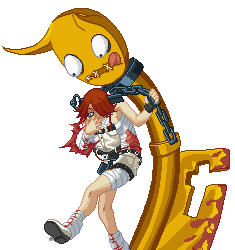
A.B.A. coughs up blood and all Paracelsus wants to do is have a taste. Note that he barely actually reacts to her or himself getting hit or fighting in the old games. It's kind of a stark contrast to his many reactions and concern for her wellbeing now.


Make no mistake, despite being "kinder and gentler" than how he treated his previous hosts - by not completely mind controlling her into a frenzy and caring enough that he doesn't want her to die - Paracelsus was truly obsessed with drinking blood still, and all the fighting skills and power he imparted on A.B.A. was to make her strong enough to defeat opponents and gather blood for him too. Hence the 'manipulation' he felt guilty of in STRIVE.
And he gets even more bloodthirsty in Moroha mode aka what Paracelsus is without his 'sanity'.
You're the worse you when on blood
Prior to STRIVE and Paracelsus' current sludgy form, his powered-up form gave him a goat's head and his persona changes into that of his old berserker self.
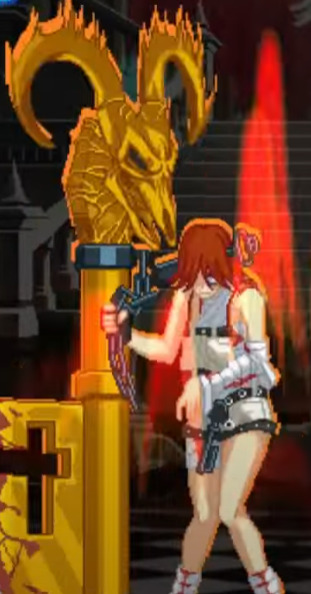
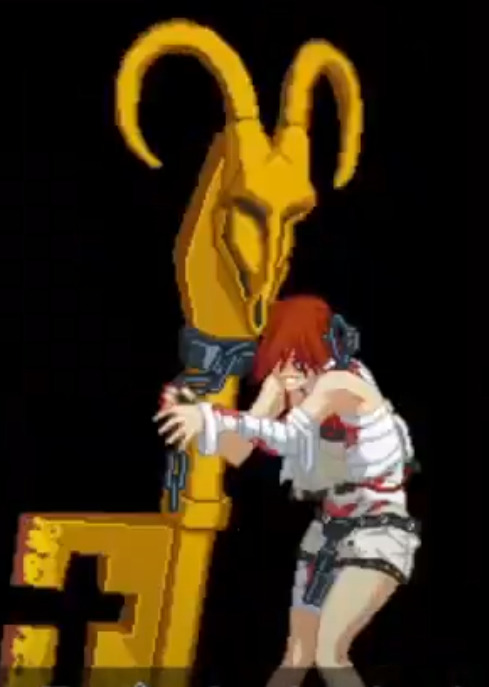
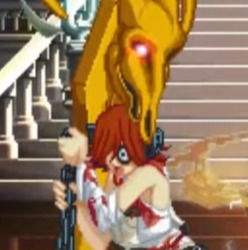
This increase in aggression and bloodlust also affected A.B.A. through their empathetic bond, making her also take joy in violence and also clearly hyperventilating and tweaking out in some animations, like she's high.
Not to mention that to fight in this mode, every time Paracelsus makes a successful attack, A.B.A. also gets damaged (hence 'Moroha' mode as it means 'double-edged'). In-universe, this could mean that Paracelsus is sapping both the blood of an opponent and A.B.A. at the same time, indiscriminately as he says.
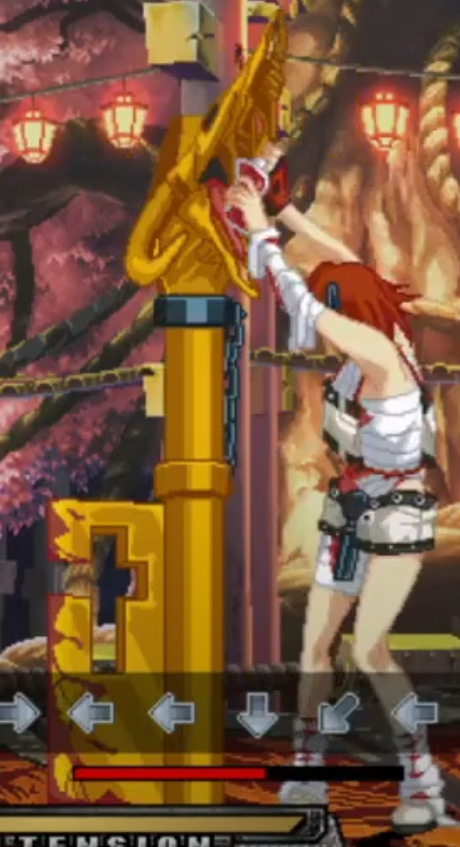
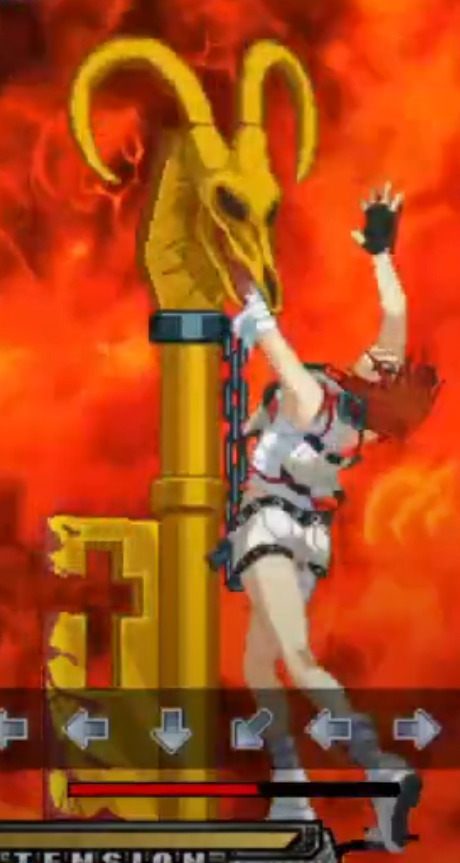
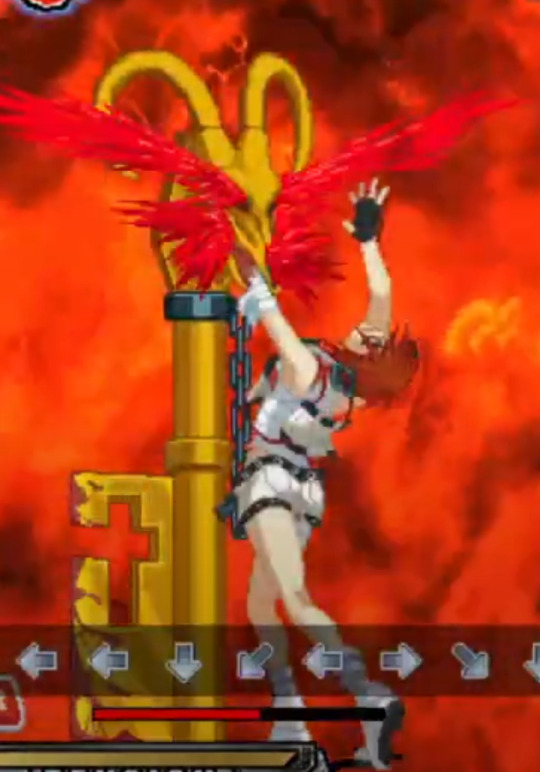
And he seems somewhat crueler in this form, as he has an even more violent and vicious state above Moroha mode called Goku Moroha mode. He enters it by consuming another blood pack, but he also seems to bite down on A.B.A.'s hand without a care and holds onto it while he transforms.
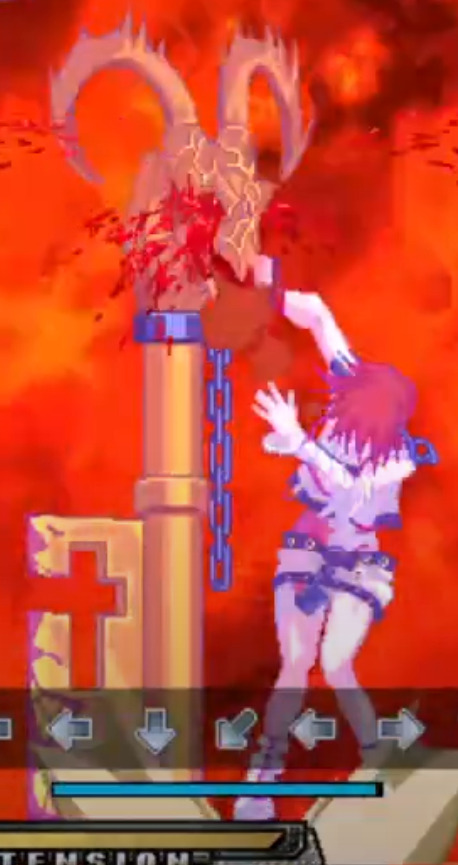

The impact of all this on A.B.A
Picking up Paracelsus was truly a double-edged sword/axe for A.B.A. On one hand, he was older and savvier about the outside world (even though he spent like 20 years just rusting away on the ground somewhere) and having him as her emotional support key and literal weapon led her to actually daring to explore the outside world, and he provided and (attempted to) advised her on things she didn't know about.
On the other hand, Paracelsus' satiating his bloodthirst was still his main objective, and it was also hurting A.B.A. Although Paracelsus was making some effort to not outright get her killed, A.B.A's additional resilience as a homunculus probably also helped her survive take being Paracelsus' host as long as she did.
Paracelsus was the original toxic element in their relationship, and it's likely over the years he's come to realize and regrets the harm he was doing to A.B.A. constantly, and why he has completely sworn off blood and violence entirely by STRIVE.

However, his bloodlust fueled and amplified the worse tendencies of A.B.A. from early on, and this seems to have stuck with her till the present in STRIVE. Her current extremely violent reaction when feeling jealousy or anxiety is likely how she's been conditioned to do so by Paracelsus, even when he himself is no longer the source of that bloodlust.
The difference now is that A.B.A.'s new powered-up state of Jealous Rage is mainly fueled by her wrath and fear instead of Paracelsus' bloodlust. Paracelsus becomes sludge now, affected by the toxicity of her unstable emotions going haywire and her will becoming decidedly dominant over his. The one who is toxic has become inverted.
What's more, it seems that the skills Paracelsus imparted on her before also carried over and stuck with her, allowing her to fight independently since Paracelsus isn't trying to encourage her to violence this time. She's become so dominant that she now can even force a new form/transformation onto Paracelsus when she does her Overdrive The Law is Key, Key is King while in Jealous Rage.
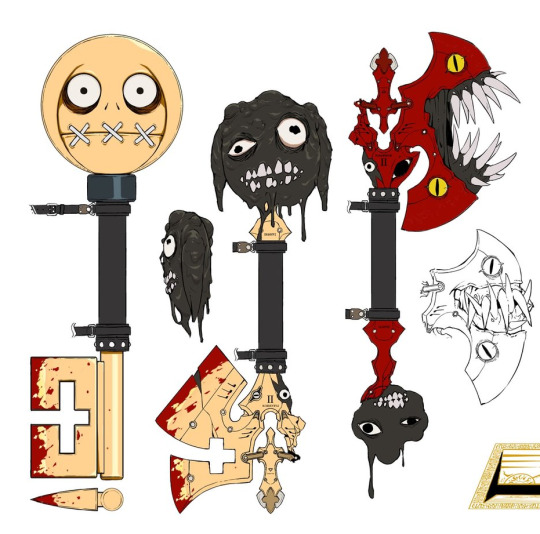
In the game files, this red form is called the "Hyoui" form, meaning 'possession'. It being red is interesting because it seems to be a callback to Paracelsus' moniker of being the Sanguine Gale. The concept art also shows the pretty disturbing way he's being morphed into it by A.B.A. when she does the Overdrive.
When in her Jealous Rage mode, the bottom half Paracelsus' where his axe blade is, somehow becomes more axe-like than it ever has been in the games. In the earlier games, his blade half didn't change, only his head does into the goat-head. What's more disturbing is that eyes already started appearing on the axe half even while Paracelsus tries to maintain his original face as much as possible.
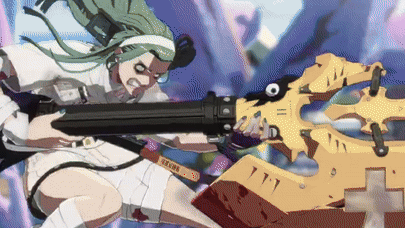
When executing the Overdrive, A.B.A. swings with the axe half as the sludge pulls from Paracelsus' face to form this new toothed red axe head. Is it a new persona? Is Paracelsus still conscious in his face half or in the axe half at all? Does 'possession' have double meaning where A.B.A. is possessed by her own wrath, but also Paracelsus is now the one being possessed by A.B.A.'s will into forming the red axe form?
The interesting thing too is that A.B.A. executes the Overdrive with precise strikes, liked a skilled warrior. IMO, at this moment A.B.A. ironically became the exact kind of warrior that berserker Paracelsus would have wanted and caused him to even revert back into that primal early form of his that was barely sentient. They gained perfect synergy for the attack, but both are literally out of their minds.
What started this post
Just a funny thing but the reason why I even thought of, and then looked into all this, was because of A.B.A.'s biting of Paracelsus at the top of the post. I was wondering why Paracelsus doesn't say a word of protest when she does this to him, then remembered that he used to kinda drink her blood (and turns out he too has bitten her before), and I think he's prolly thinking "I deserve this".
#guilty gear strive#a.b.a guilty gear#paracelsus guilty gear#long post is long#my analysis#paraba#arc system works#aba guilty gear
530 notes
·
View notes
Note
your art is so cute! can you draw (human)paracelsus or testament? id love to see either of them in your style :)


THANK YOU ANON !!! here's both, because i felt like drawing both >:33 i hope you like it!!! drew paracelsus a ponytail cuz... why not.... also testament's older design cuz i feel that one slays hard 🖤
370 notes
·
View notes
Text
Guide to Literary, Historical, Folklore and Alchemist Themes in "Nosferatu" (2024)
After my post about how the film itself debunks every "popular" view on “Nosferatu” (2024); and the ending explained through cast and crew interviews, (I did full breakdowns on here and on my personal blog), here’s a list of references in “Nosferatu” (2024):
Literary themes: "Dracula" by Bram Stoker (1897); and "Wuthering Heights" by Emily Brontë (1847);
Historical themes: early 19th century (1838), Victorian era. Strict gender roles; views on female sexuality (sickness; contagious; sin) as a marital duty, owned and controlled by their husbands; sexual repression/liberation; Ellen’s mediumship medicalized as “hysteria” and “melancholia”; “love” and “passion” as opposite concepts;
Folklore themes: Changeling (European); Strigoi myth (Balkans); Șolomonari (Romanian); Nachzehrer (Germanic);
Occult themes: Agrippa; Angels and daemons; Enchantress; Babalon and the Beast (New Age of Aquarius);
Alchemist themes:"Sylph" and Paracelsus; Humorism (Humoral theory); Alchemical Gold (Chrysopoeia; Gold-making); Myth of Isis and Osiris.
Literary themes
"Dracula" by Bram Stoker
"The Threat of Female Sexual Expression": Based on 1980's Feminist Literary Criticism (Second Wave of Feminism). the physical figure of the "sick woman" as one of the principal ways in which female sexuality manifests as a contagious disease (Lucy Westenra and her degeneration into vampirism) - Ellen's character as seen by the Victorian characters (especially Friedrich Harding)
19th century "Contagionism" theory: Victorian medicine on disease origin. Disease spread from individual to individual (neglecting environmental issues like polluted water or unhygienic spaces)

"I thought it was agreed you were to keep the girls from her. You mustn’t be swept up in her fairy ways."
Subverted Themes:
Robert Eggers subverted every literary theme in “Dracula”, like he said in one interview: “My influences are all very clear, and Nosferatu is a remake, after all,” Eggers says, yet he plays with the canon, with expectations and clichés – “hopefully subverting them to do something unexpected.”
The Promise of Christian Salvation: This is a Anti-Christian story, at its core. Religious items have no power against Orlok; the fact he can’t enter the Orthodox convent has nothing to do with God (but with him not being given entrance); the God-fearing and religious character (Anna) is the first to die; and the female heroine Ellen not only rejects God (calls it “destiny) but also says she needs no salvation (rejecting Christian salvation, completely);
Madness: Neither Ellen, Professor Von Franz nor Herr Knock are “lunatics”, but the Victorian characters think they are. Knock is in full control of his mental capacities, he’s just a religious fanatic obsessed in discovering Orlok’s secret to immortality and he’s behaving the way he does because he wants to become a strigoi, too, and will stop at nothing to achieve it (even seeking a “violent death” to seal the deal);
The Consequences of Modernity: Ellen’s character and the medicalization of her supernatural gifts and mediumship by Victorian society;
Money: in the novel it’s associated with Count Dracula evilness; here with the Victorian characters. Friedrich Harding (the Victorian patriarch) is wealthy and loans money to Thomas, who drowns himself in debt, in his ambition to climb the social ladder and being “no longer a pauper”. Ellen, the female heroine, rejects money. Orlok gives Thomas a sack of gold in exchange for his signature in the “covenant papers” (the divorce papers) as he’s paying for Ellen’s dowery;
The Threat of Female Sexual Expression: Ellen breaks Nosferatu curse and “saves the day” by embracing her sexuality.




"Wuthering Heights" by Emily Brontë
“I think that what ultimately rose to the top, as the theme or trope that was most compelling to me, was that of the demon-lover. In “Dracula,” the book by Bram Stoker, the vampire is coming to England, seemingly, for world domination. Lucy and Mina are just convenient throats that happen to be around. But in this “Nosferatu,” he’s coming for Ellen. This love triangle that is similar to “Wuthering Heights,” the novel, was more compelling to me than any political themes.”
Dream of Death: Robert Eggers on “Nosferatu” Interview
Love triangle between a free-spirited and medicalized woman (Catherine/Ellen) with a beastly men (Heathcliff/Orlok) and a gentleman (Edgar/Thomas);
Themes of the all-consuming, obsessive and self-destructive passion, wrecking the lives of everyone around them and only stops when they are both dead;
The Destructive Power of Love;
Blend of Hatred and Love;
Separated by death/United by death; couldn’t be together in life, united in death and reunited in the spiritual world.


Historical Themes
Historical context: early 19th century (1838), Victorian era
Strict gender roles: marriage and motherhood as a woman’s destiny; social reputation and provider as a men’s destiny; domestic (women) vs. public (men) spheres;
Infantilization of women: the ideal Victorian woman was a model of virtue, purity and modesty who obeyed their husbands; women were seen as innocent, ignorant and naïve about the world, and were thought to have no minds of their own; the average Victorian woman wasn't allowed to be educated nor possess knowledge outside of domestic life. A woman’s entire life revolved around men: obeying their fathers, preparing for marriage, seeking an husband and as a wife, living for her husband;
Women as their husbands' property; marriage was the institution where Victorian men fully accomplished their male responsibility and privilege: to form a household, provide safety and comfort, and exercise authority over dependents (wife and children) where the trademark of a successful man. This was also connected to their social and professional success, making them respectful in the eyes of other men. A man who couldn’t govern his wife was also seen as unfit, socially, professionally and morally; and the wife’s behavior would reflect on the husband (which is why Friedrich Harding accuses Ellen of being a social embarrassment to Thomas);

"I envy you. You’ve truly taken your father’s place now… it’s incredible."
Victorian views on female sexuality: female sexuality seen as a plague and a monstrosity in need of containment (sickness, contagious, wicked, sin); women should have no sexual desire whatsoever (Ellen's shame; "I'm unclean"); married heterosexual sex was the only socially acceptable sexual expression in the Victorian era, and everything else (masturbation, homosexuality, prostitution, etc.) was considered deviant, “sinful” and “evil”; sex was a marital duty women had to go through to have children and serve their husbands (women’s sexuality owned and controlled by their husbands);
Sexual repression/liberation, represented by her corset, as Linda Muir, the costume designer, reveals in her interview "The Costumes of ‘Nosferatu’ Are Gorgeous - They Also Tell a Story About Female Repression and Liberation": “Her [Ellen] true nature [takes over] in the end. She liberates herself by ripping herself open, ripping her striped dress open. She liberates herself by wearing the same garment over and over and over again when she’s staying at Harding’s home. So she’s liberated herself in that she doesn’t feel the need to dress up completely each and every day. And then she liberates herself completely in the end.”
“Love” and “Passion” as opposite concepts: Victorian love (Thomas) was meant to be chaste, modest and restrained, tempered devotion confined to the household; and the sacrament of marriage ("sacred") was meant to repress and contain "passion". Passion (Orlok), on the other hands, was erotism, sexuality and sexual desire, considered "animalistic" and corruptive.


"Find the dignity to display the respect to your caretaker. And for your husband’s sake, I pray you might learn to conduct yourself with more deference."
Ellen’s mediumship medicalized as “hysteria” and “melancholia”: Robert Eggers tells us: “[Ellen is a] victim to 19th-century society […] she can see into another realm, and has a certain kind of understanding that she doesn’t have the language for,” Eggers said. “But people are calling her melancholic and hysteric and all of these things.” and in another interview: “she [Ellen] has this understanding of this other world, and this other way of thinking that she doesn’t have language for, so she’s isolated. But the pull to it is very strong, and so people consider her melancholic and hysterical, and we can see her fighting within herself. I think having it stem from the realities of a woman who’s a victim of 19th-century society is something that makes it hopefully work."
And in another: “she’s [Ellen] as much a victim of 19th-century society as she is a victim of the vampire. People talk a lot about Lily-Rose Depp’s character’s sexual desire, which is a massive part of the character, of what she experiences — being shut down, and corseted up, and tied to the bed, and quieted with ether. Misunderstood, misdiagnosed. But it’s more than that. She has an innate understanding about the shadow side of the world that we live in that she doesn’t have language for. This gift and power that she has isn’t in an environment where it’s being cultivated, to put it mildly. It’s pretty tragic. Then she makes the ultimate sacrifice, and she’s able to reclaim this power through death.”
“She’s [Ellen] an outsider. She has this understanding about the shadow side of life that is very deep, but she doesn’t have language for that. She’s totally misunderstood and no one can see her […] this demon lover, this vampire, who is the one being who can connect with that side of her." (x)
“Ellen’s husband loves her, but he can’t understand these ‘hysteric’ and ‘melancholic’ feelings she’s experiencing, and he’s dismissive of her. The only person she really finds a connection with is this monster, and that love triangle is so compelling to me, partially because of how tragic it is.” (x)
The Victorian characters and Victorian society are the actual villains of the story; which subverts, another theme of the "Dracula" novel (where the titular vampire is the villain).
Folklore Themes
Changeling (European folklore)

"Father… he would find me in our fields… within the forest… as if – I was his little changeling girl."
“Changelings” are human-like creatures from European folklore. They are children kidnapped by fairies, elves or demons and a substitute child being left in their place. Ellen's father called her this because she she enjoyed playing and being in nature, when she was supposed to be indoors (domestic sphere).
Strigoi (Balkan Folklore)
Count Orlok: quintessential strigoi morti, a undead creature from Dacian mythology and, consequently, from Romanian folklore, who raises from its grave to feed on the living and must return to it before dawn:
Appearance: walking corpse; bald and leathery; skin infested with maggots, cracked and oozing with putrescence and decay; long, spidery fingers; fangs cannot be retracted (sores on his lips and chin); dressed in moldy, torn out clothing (the one he was buried in);
Cause of curse: Ellen resurrected Orlok and cursed him at the prologue (confirmed four times in the film). Connected with his tragic backstory Robert Eggers won't share with the public (but influenced Bill Skarsgård entire performance and gives meaning to the ending of the film); late 16th century voivoide (count) from Transylvania, was married (couple bedroom where he attacks Thomas) and had a family (multiple sarcophaguses on his castle cript);
Characteristics: "psychic vampire"; it's not blood he feeds on specifically, but souls (soul trapped in the blood), and that's what sustains him (and that's why Thomas had to be exorcised). Plague-carrier ("blood plague"); controls animals (rats and wolves); astral projection powers (shadow); and manipulation of dreams (nightmares to create fear).
Haunting: strigoi haunt the person they loved the most when they were alive, and drag them to their grave. Reincarnation theme.

Strigoi "repelling" blessings and tokens:


“Dau cu ustoroi de strigoi”
Ritual to locate a strigoi grave:


"The means of repelling and destroying vary greatly from region to region [...] Their efficacy is plainly unknown. Boiling wine, a spike of cold iron transpiercing the navel, decapitation, incineration…" Professor Von Franz to Dr. Sievers
A virgin girl on horseback will be attracted to the strigoi grave and locate it. Then the strigoi can be killed. Here with a spike of cold iron. This ritual is all wrong on purpose, because it’s usually a black stallion and done during the day (when strigoi are resting on their graves). No strigoi was killed in this scene because the Roma people work for Orlok (as in the "Dracula" novel) and he wanted Thomas to see this ritual.
Șolomonari (Romanian Folklore)


"A black enchanter he [Orlok] was in life. Solomonari. The Devil preserved his soul that his corpse may walk again in blaspheme."
Șolomonari are dark wizards from Romanian folklore, who were believed to ride a dragon (“balaur”) and control the weather (rain, thunder, storms), and usually lived as beggars. The were frequently recruited among the common people and taught black magic at the Solomonărie (or “Scholomance”, in the Germanic version); some call it “Devil’s school”, others “School of the Dragon”. They are said to be taught by the Devil himself, and their school was located underground, in the Carpathian Mountains, in Transylvania. The name Șolomonari is often associated with King Solomon and alchemy.
According to folklore, there were seven, ten or thirteen students, who didn’t saw the sunlight during the seven or nine years duration of their studies. Some accounts describe them as “strigoi vii” (living strigoi; wizards and witches); but this isn’t Orlok’s case otherwise Robert Eggers wouldn’t be so secretive about his backstory (the reason for his curse is something else). At the Solomonărie, they learned magic (spells), the secrets of nature and the language of all living things; as well as ride flying dragons and control the rain.


As their final assignment to become a Șolomonar, they had to copy their entire knowledge of humanity into a “Șolomonar’s book”, a book of wisdom, which would become the source of their power. Which is what we see in “Nosferatu” with the Șolomonar codex of secrets Professor Von Franz finds in Herr Knock’s office; it was written by Orlok himself.

At the end, it’s said one of the students was chosen by the Devil to be the “Weathermaker” and tasked with riding a dragon to control the weather. This dragon was said to be kept submerged in a mountaintop lake, south of Sibiu. While the other was selected to be servant to the Devil himself; which is what the Orthodox Nuns believe Orlok to be, as does Professor Von Franz.
“Our Nosferatu is of an especial malignancy. He is an arch-enchanter, Solomonari, Satan's own learned disciple.”
However, Orlok is no “devil worshipper”, because like his iconography tells us, he’s a Pagan enchanter, follower of the Dacian god Zalmoxis, owner of the secrets of life and death.
The "demonized Pagan": the connection between Zalmoxis worship and the folkloric Șolomonari began in the early 20th century by Romanian social scientist Traian Herseni, who proposed the “Dacian cloud travelers” and “Șolomonari weathermakers” are connected, and this myth has its roots in Dacian religion. Nowadays, this theory is openly embraced by xenoarchaeologist Jason Colavito. No matter the historic validity, this is the interpretation Robert Eggers is using in “Nosferatu” (2024).


Orlok sigil: an heptagram (seven-pointed star) surrounded by a Dacian Draco ouroboros (rebirth; reincarnation; immortality); the letters are cyrillic for “Zalmoxis”; the center is the alchemist symbol for blood; the symbols appear to be Vinča; archeological findings in Romania with these symbols being over 8,000 and 6,500 years old, and consider by many as the oldest form of human writing, but their meaning is still unknown (they are here either to show Orlok comes from an ancient bloodline; or he has known reincarnations throughout the ages)
Heptagrams are connected to the seven elements of Alchemy but aren’t represented like this. Heptagrams are also connected to divine feminine goddesses, like Babalon and Isis.
Nachzehrer (Germanic Folklore)
When Professor Von Franz discovers the Șolomonari book in Herr Knock's office, he also finds a cryptic writting: "His thunder roars from clouds of carcasses, I feedeth on my shroud, and death avails me not. For I am his.”
This is based on Germanic folklore, where the "nachzehrer", also known as "shroud eater", is a sort of vampire who needs to devour both its burial shroud and body in order to survive. It's immortal, and lives off humans even after death. In folklore, it's believed the most common way for a person to become a nachzehrer is to commit suicide or die accidentally (which is what happens to Herr Knock and what he was seeking). It's also associated with disease, for in Germanic folklore, when a large number of people die because of a plague, the first people to have succumbed to it would be transformed into a nachzehrer.

Occult Themes
Agrippa
"He [Professor Von Franz] became obsessed with the work of Paracelsus, Agrippa, and the like [...] Alchemy, mystic philosophy… the occult."
Henry Cornelius Agrippa von Nettesheim was one of the most famous occultists in Europe in the 16th century. He was a versatile scholar, and knowledgeable in the fields of science, medicine, magic, philosophy and theology. However, he was dismissed as a charlatan and self-promoter by many, while others praised him for his pioneer role in the scientific revolution, especially due to his intellectual curiosity (in opposition to the church authority).
His works incorporated elements of the cabala, numerology, mathematics and theology; a mix of Christianity, Neo-Platonism and occult science. His most notorious treaty is called “The Nobility of the Feminine Sex” (1532) where he asserts the natural superiority of women, and counterarguments Greek and Roman philosophers and even the Christian Bible, advocating for social gender equality.
Professor Von Franz is probably based on Agrippa, mostly his “reputation” as a charlatan and self-promoter (he’s an outcast in Victorian society and considered a “lunatic”), and he's the only human character who recognizes and respects Ellen’s supernatural gifts, as well as her agency.
Angels and daemons
When Professor Von Franz tries to determine with whom Ellen is communicating with, he uses his Abraxas stone ring to compel her to speak, and he conjures both angels and demons during this scene:
"Who, damn you!? Speak!! I command you, hearken to my voice. By the protection of Chamuel, Haniel, and Zadkiel, impart your speech unto me. In the name of Eligos, Orabas, and Asmoday, impart your speech unto me."
Chamuel: Also known as Kamael, "One who seeks God", is the angel of peaceful relationships, and considered one of the seven Archangels (who have the honor of living in God's direct presence in Heaven) by Jewish Kabbalah and some Christians;
Haniel: "Joy of God", is the Archangel of joy who's known for taking Enoch to Heaven;
Zadkiel: "righteousness of God", is the angel of God's mercy;
Eligos: is a "Great Duke of Hell", ruling 60 legions of demons. He reveals hidden things and knows the future of wars;
Orabas: is a "Great Prince of Hell", with 20 legions of demons under his control. He answers questions and gives one power and control over others;
Asmoday: is the "King of Demons", in the legends of Solomon and the constructing of Solomon's Temple.
Abraxas stone rings were considered magical talismans or charms since the Middle-ages, connected to the Seven Olympic Spirits (Aratron (Saturn); Bethor (Jupiter); Phaleg (Mars); Och (Sun); Hagith (Venus); Ophiel (Mercury) and Phul (Moon)); and to Gnosticism (personal spiritual knowledge above organized religion), who considered Abraxas as “the God above all Gods”.
This is also connected to Agrippa, “Occult Philosophy”, book three, which covers the intellectual world of Pagan gods and spirits (including angels and demons), and gives magical procedures for invocation and communication with them, as well as with God (sigils, amulets, magical alphabets, sound, perfumes, etc.); and the kabbalistic tree of life (hierarchies of angels and Demons associated with each sephirot). The idea behind this conjuring is to infuse the lower angelic orders with the light they receive from God, as they instruct the orders.
Enchantress
Ellen has been a somnambulist since infancy, and she always had supernatural abilities; premonitions (“I know things”), as she would know what her Christmas presents were before opening them, and when her mother would die, which indicates she always had a connection to the spiritual world.
Professor Von Franz recognizes Ellen's spiritual power and ability to communicate with the spiritual world (“I believe she has always been highly conductive to these cosmic forces, uniquely so”). She's a medium (or a psychic); someone with the ability to connect with the spirits of deceased loved ones, spirit guides, and other non-physical entities.
What the Victorian doctors call “hysterical fits” and “epilepsies”, are, in fact, trance-like states of spiritual communication (trance mediumship), similar to Pagan priestesses. Like Von Franz tells the audience, Ellen inhabits the “borderland”, a peripheral area, a portal between the two worlds: the physical (matter) and the spiritual. And this is what Victorian society medicalizes in Ellen, and tries to restrain with drugs and corsets, not only her sexual nature, but her spiritual power, her own nature.
Orlok calls Ellen "enchantress". Historically, enchantresses were practitioners of feminine magic: oracles, healers, herbalists, midwives and shamanic shapeshifters. They were what’s commonly known as “witches”. These female magicians studied and practiced their art in goddess temples, mystery schools, alchemy schools and hedge schools. The alchemists of the Middle-ages studied these dynastic lineages of “wise women”, and they had several names: "enchantresses", "chantresses", "encantrices", or "incantrix".
Ellen is, then, a "incantrix": uses words, incantations, songs, spells and prayers to shape reality. They were, also, the priestess of an old religion (as Professor Von Franz also calls her "great priestess of Isis"), gifted with magic power and authority to command the elements or the body by the power of their word.
Babalon and the Beast (New Age of Aquarius)
The birth of the New Aquarius was already the occult meaning of the original 1922 “Nosferatu”, because Albin Grau was a student of the occult and a member of the Fraternitas Saturni (German magical order devoted to Saturnian doctrines) under the magical name Master Pacitius. Within the occult leaders there was tension due to their beliefs, and Grau eventually sided with Aleister Crowley Thelema (which views we see in Eggers “Nosferatu”).
While Stoker saw Count Dracula as pure evil, Grau reinterpreted the vampire as a symbol of transformation through confrontation with darkness. Saturn, in esoteric tradition, represents restriction, death, and rebirth (the forces that initiate profound spiritual change). Grau viewed the vampire as a reflection of these principles, a shadowy force that compels the aspirant to face mortality, fear, and their own inner darkness. And his death symbolized the birth of the New Age of Aquarius (Saturn as ruler of Aquarius), a new era of collective awakening and innovation.
Robert Eggers included the divine feminine (Babalon), his heroine is already a dark character, as he describes his Ellen as “dark chthonic female heroine”, who makes the ultimate sacrifice to "reclaim this power through death". Chthonic = gods or spirits who inhabit the Underworld; and, in his version, Orlok gifts Ellen with immortality and rebirth (not death like in the original "Nosferatu").
When Ellen and Thomas are returning home, there’s a man in the streets rambling bits from the “Book of Revelations” (Apocalipse) from the Bible: “And I saw a beast rising out of the sea, owith ten horns and seven heads, with ten diadems on its horns and blasphemous names on its heads.” (Revelations, 13:1).
This passage is about Orlok arrival and his "blood plague", but there's a character (also from the "Book of Revelations") connected to this beast: the Whore of Babylon, the “Mother of Prostitutes and All Abominations of the Earth”, and she rides this Beast, which is the same as Crowley’s Babalon. What Crowley did was a positive reinterpretation of this biblical figure, symbolizing liberated female sexuality by embracing the powers of the Divine Harlot.
Initiatrix, Creator and Destroyer, Babalon is the “Great Mother” because she represents Mother Earth. Like Isis, she’s the Archetypical Mother, the Womb, the Great Sea and the Divine Blood itself. According to Crowley, the “whore/harlot” facet is about enjoying sex without the burden of reproduction; and the “mother of abominations” connects with destruction like natural catastrophes, plagues, etc. She’s the ruler of the cosmological sphere and both good and evil (as evil as elemental forces can be or are considered as). Babalon is the guardian of the Seven Principles of the Underworld, a place of darkness and transformation. Babalon is also the goddess of the liminal point, who can access other realms. As Goddess of vengeance, Babalon punishes when life is out of balance, and exerts violence and corruption upon those who are in the wrong. Ellen ("mother of abominations") unleashes Orlok onto the world, and we can interpret him bringing plague into Wisburg as Ellen’s reckoning against Victorian society, which ostracizes her and will never accept her.
According to the Thelema, Babalon is the “Sacred Whore”, and her primary symbol is the Chalice or Graal (symbolic womb). She’s a consort to the Beast, who has seven heads, which is symbolically represented in her heptagram sigil (parallelling Orlok's heptagram). To Crowley these are archetypes in his Sex Magick beliefs: the “Scarlet Woman” is the High Priestess, and the “Beast” is the Hierophant: Ellen (the priestess, enchantress) and Orlok (priest-shamam; enchanter). Orlok is described as a “beast” several times in the film, and he says Ellen’s passion is bound to him, like Babalon’s passion is united with the Beast.
All rites and initiations of the Underworld Goddesses include rites of sex and death. Which is what we see with Ellen at the end of “Nosferatu” (2024). By Thelemic occult tradition, she, the manifestation of Babalon, has sex with the Beast (Orlok), “representing the passion which unites them” and her womb (Holy Grail; cup) is “aflame with love and death” (sexual climax, orgasm, with an un-dead vampire), to give birth to the New Age of Aquarius.
Crowley described Babalon:
“She rides astride the Beast; in her left hand she holds the reins, representing the passion which unites them. In her right she holds aloft the cup, the Holy Grail aflame with love and death. In this cup are mingled the elements of the sacrament of the Aeon”.

"the cup, the Holy Grail" = womb
"Aflame" = orgasm
"with love and death" = sex with undead Orlok
"sacrament of the Aeon" = the "aeon" in Thelema is a spiritual age, in this case it's Ellen's womb who gives birth to the New Age of Aquarius
Alchemy Themes
"Sylph" and Paracelsus
"Do extend my tardy congratulations to your wife. She is truly a… A nonpareil of beauty. Almost a sylph." Herr Knock to Thomas Hutter
A “sylph” is air spirit (or nymph) from the 16th century works of Swiss physician, alchemist and theologist Paracelsus, with roots in folklore. Sylphs are invisible beings of air (or air elementals), connected to fairies and pixies. On his “A Book on Nymphs, Sylphs, Pygmies and Salamanders, and Other Spirits”, Paracelsus described the four elemental beings, each corresponding to one: Salamanders (fire), Gnomes (Earth), Undines (water) and sylphs (air).
Sylphs are formed and live in air, and they have power over the air element, particularly the wind and the clouds, where they move freely. They do not fare well outside of their element; they burn in fire, drown in water and get stuck in earth. They are portrayed as the guardians of secret knowledge, and protectors of nature.
During the 19th century, there was a renewed interest in sylphs in European society, especially in theatre, where they appeared in several plays and operas as ethereal, graceful, charming and ultimately unattainable.
Ellen is compared to a fairy three times in the narrative: by Herr Knock ("sylph"), by her father ("his little changeling girl") and Friedrich Harding ("her fairy ways"). We also see her floating at the prologue when she meets Orlok.
Humorism (Humoral theory)

“You [Dr. Sievers] have bled her to decrease the congestion? […] And her menstruations are also? [Liberal]. Too much blood. Too much.”
Professor Von Franz physically examines Ellen, as her trance is beginning, and determines she has “too much blood”: in connection to “Humorism” (or “humoral theory”) with possible origins in Ancient Egyptian medicine, and then used by Ancient Greeks and Romans. Hippocrates suggested that humors are the vital bodily fluids, and they are four: blood, phlegm, yellow bile, and black bile. This belief was common during Middle-ages in Europe.
Ellen having “too much blood” means she has a sanguine temperament (not a melancholic temperament); it was believed that, when in good health, “sanguines” are cheerful and loving; but when there’s an imbalance, they are “hysterical”, which is what Victorian doctors also diagnose Ellen as (“hysteria”).
The treatment is bloodletting (bleed the patient, drain their blood; a practice still used in the early 19th century), to remove the excessive blood; which is what Von Franz also advices in Ellen’s case. “Congestion”, in the medical sense of this time period, means “containing an unnatural accumulation of fluid”, in Ellen’s case it’s blood. This diagnose will come full circle when Thomas and Dr. Sievers discover that Orlok is with Ellen when they go to Grünewald Manor. Von Franz tells them “She wills it! Your wife wills it!” and Orlok himself “can’t resist her blood", which means Orlok cannot resist Ellen, herself.
Mutual healing theme: At the end, Orlok drains Ellen of her excessive blood, balancing her “sanguine temperament” and ending her “hysteria” and “melancholy” (he also gives her an orgasm, a nod to hysteria as repressed and frustrated female sexuality); and Ellen’s love and willing sacrifice sets their spirits free from the rotten vessel they were trapped in ("and freed them from the plague of Nosferatu"); as they are reunited in the spiritual realm, now fully healed.
Alchemical Gold (Chrysopoeia; Gold-making)
"I had nearly unlocked the final key of the Mysteriorum Libri Quinque. No… No matter. I miscalculated the stars. Hermes will not render my black sulfur gold this evening." Professor Von Franz to Dr. Sievers and Friedrich Harding
“Mysteriorum Libri Quinque” is part of a collection of mystic writings by mathematician, hermetic philosopher and astronomer Dr. John Dee (16th century). An avid learner of the secrets of nature, he made no distinctions between mathematical research and the supernatural (which he considered mere tools to achieve a transcendent understanding of divine forms underlying the visible world, called “pure verities”). In 1580, he began experimenting with evocations to contact and communicate with angels, and Edward Kelly joined him in this project in 1582. They both documented every interaction they had with angels and wrote about their language, which they called “Enochian”. This collection of esoteric writings was only found, by accident, after John Dee’s death.
Alchemy, at its core, is the transmutation of base materials (lead, etc.) into noble materials (gold), and the pursuit of immortality (“philosopher’s stone”). Occultists reinterpreted this as a spiritual quest of self-transformation, purification and regeneration of the human soul. Hence physical death being seen as a gateway to another life (rebirth, reincarnation).
Both Ellen and Orlok evolve from a diseased and corruptive state (physical world; black sulfur) into regenerative and perfect state (spiritual world; gold), after being purified by fire (Sun). Their old selves are empty shells, as their spirits ascend. This also finds parallel in the myth of Isis and Osiris, as they both went from “daemons” to Gods in the Plutarch essay.


"I believe only you have the faculty to redeem us [...] You are our salvation."
At the end, Von Franz succeeds in transform black sulfur into gold, as he, too, emerges redeemed and avenged by Ellen’s fulfilling her covenant with Orlok.
In modern occult beliefs, alchemy is considered as a mystical system designed to transmute the soul from a “base” or “leaden” state of spiritual impurity to a “gold” or purified state of divinity, with the chemical procedures of alchemy being an elaborate metaphor for psycho-spiritual development. This idea was popularized by Carl Jung, among others.
In alchemy, this “gold” wasn’t like common gold, it was a miraculous, incorruptible substance, “the true and indubitable treasure”, which could only be perceived by those who can see with their mind’s eye: “Nolite dare sanctum canibus” (“Do not reveal what is sacred to dogs”) and “Neque mittatis margaritas vestra ante porcos” (“Nor cast your pearls before swine”).
Myth of Isis and Osiris
"In heathen times you might have been a great priestess of Isis."
The “Osiris Myth” is one of the major surviving pieces of Egyptian mythology. It’s a ancient tale, with its early versions dating back to the 5th Dynasty (c. 24th century B.C.). It has known several adaptations throughout Egyptian history. The most complete version is in “The Moralia” by the 1st-century scholar Plutarch of Chaeronea, a collection of essays about Greco-Roman culture; that became very popular during the Renaissance era (14-16th centuries) and the Enlightenment period (18th century) in Europe.
Isis and Osiris were brothers, and according to Ancient Egyptian religion, they were in love with one another before they were born, and enjoyed each other in the dark before they came into the world. They eventually married. They had a brother, Seth (or Typhon in Plutarch essays), the God of deserts, storms, disorder and violence, who murdered Osiris to take his throne. He tricked Osiris into climbing into a wooden chest/coffin, shut the lid, sealed it shut, and threw it down the Nile River, knowing Osiris would never be able to survive. In some versions, it’s said Seth cut Osiris body into pieces and scattered them throughout Egypt.
Osiris had two facets as a God: in life, he was the God of fertility, agriculture, and vegetation, being considered a “Shepherd God”; in death, he was the God of the Underworld, the judge and Lord of Dead, the afterlife and resurrection. The pharaohs of Ancient Egypt were associated with Osiris in death, because as he rose from the dead, so would they unite with him and gain eternal life through imitative magic. Which is also the whole deal between Orlok and Herr Knock in “Nosferatu” (2024), as Knock seeks to gain immortality like Orlok, by serving him.
Isis is the epitome of the mourning widow in this myth, as she mourns Osiris’ death deeply. Here enters the symbolism of the lilacs in "Nosferatu", the symbolic flowers of Ellen and Orlok: in the Victorian era, they were associated with widows because they represented a memento of a deceased lover. Isis sought for Osiris’ mangled body and with help of tree other Gods (Nepthys, Thoth and Anubis), they sew Osiris’ body back together, and then wrapped it head to toe in strips of linen, creating a mummy. Orlok’s corpse appears almost mummified at the end of the story.
In the Osiris myth, Isis uses powerful magic (incantations and magic spells) to bring her dead lover back to life; similar to Ellen who resurrects Orlok with her summoning prayer. In one version, this happened on a night of the full moon; in “Nosferatu” (2024) we also have a full moon connected to Ellen and Orlok, in the prologue, when he reveals himself to her:

According to Ancient Egyptian funerary texts, it’s Isis sorrow, sexual desire and anger that empower her magic to be able to bring Osiris back to life. When Ellen prays for a companion of “any celestial sphere” in the prologue, she’s crying (sorrow), she’s upset because her father recoils from her now that she’s no longer a child (anger) and she’s in her teenage years/puberty (sexual desire). Like Isis with Osiris, it’s the combination of these emotions that power her magic to unconsciously resurrect Orlok.
However, Osiris can’t remain among the living, because he has to return to the Underworld and become King of the Afterlife. But before he goes, Osiris and Isis conceive Horus, the God of the sun and the sky, who will restore peace and order to the universe. In “Nosferatu” (2024), Professor Von Franz says that “with Jove’s holy light” before dawn, the plague will be lifted. “Jove” is Jupiter, the “King of the skies”, who’s connected with the Egyptian Horus. Horus and Ra are often merged together in Ancient Egyptian religion, making Isis and Osiris the metaphorical parents of the Sun.

In “Nosferatu” (2024), as Orlok and Ellen complete their covenant, consummate their wedding, the sun is also the metaphorical result of their union. As dawn breaks, the sunlight vanquishes them both from the physical world, as they both die in the material realm. After being buried by Isis, Osiris goes into the Underworld to rule over it. And from then on, Isis herself is also associated with funeral rites, as she would guide the souls of the dead, helping them entering the afterlife. Through her magic, Isis helped resurrecting the souls of the dead, as she did with Osiris, acting as a mother to the deceased, providing protection and nourishment. At the end of "Nosferatu" (2024) we see Ellen fulfilling her role as “priestess of Isis” (or as Isis herself?), as the Goddess of healing, who ends the Nosferatu curse, the blood plague in Wisburg, and also guides her dead lover Orlok with her to the Underworld.
#Nosferatu 2024#Robert Eggers#dracula#wuthering heights#romanian folklore#european folklore#alchemy#strigoi#Solomonari#Dacian mythology#germanic folklore#dr John Dee#enochian#angels and demons#changeling child#Nachzehrer#Agrippa#Myth of Isis and Osiris#Paracelsus#Humorism#humoral theory#sylph#Ellen Hutter 2024#count Orlok 2024#professor Von Franz#Thomas Hutter 2024#Friedrich Harding#Anna harding#Victorian era
83 notes
·
View notes
Text
Season 3’s theme being Love is something I had seen before, but I recently realized that the characters are, in order of release, different stages of relationships.
Johnny: Affectionate, but can’t/won’t latch onto anything specific. He’s also unaware of any greater level of love than passing interest.
Elphelt: Aware of higher levels of love, but can’t find the person to commit to. She also only sees the idealistic parts of love without any deeper meaning.
A.B.A. (and Paracelsus): They both care deeply for each other, and are fully committed to each other’s vision of the relationship. There are underlying issues and fears, but they both communicate their feelings to each other and work through problems as a unit.
Slayer (and Sharon): A dedicated mutual relationship. Both sides benefit and support the other. No further development needed
#guilty gear#ggst#guilty gear strive#johnny guilty gear#elphelt valentine#elphelt guilty gear#aba guilty gear#a.b.a#a.b.a guilty gear#paracelsus#slayer guilty gear#slayer
285 notes
·
View notes